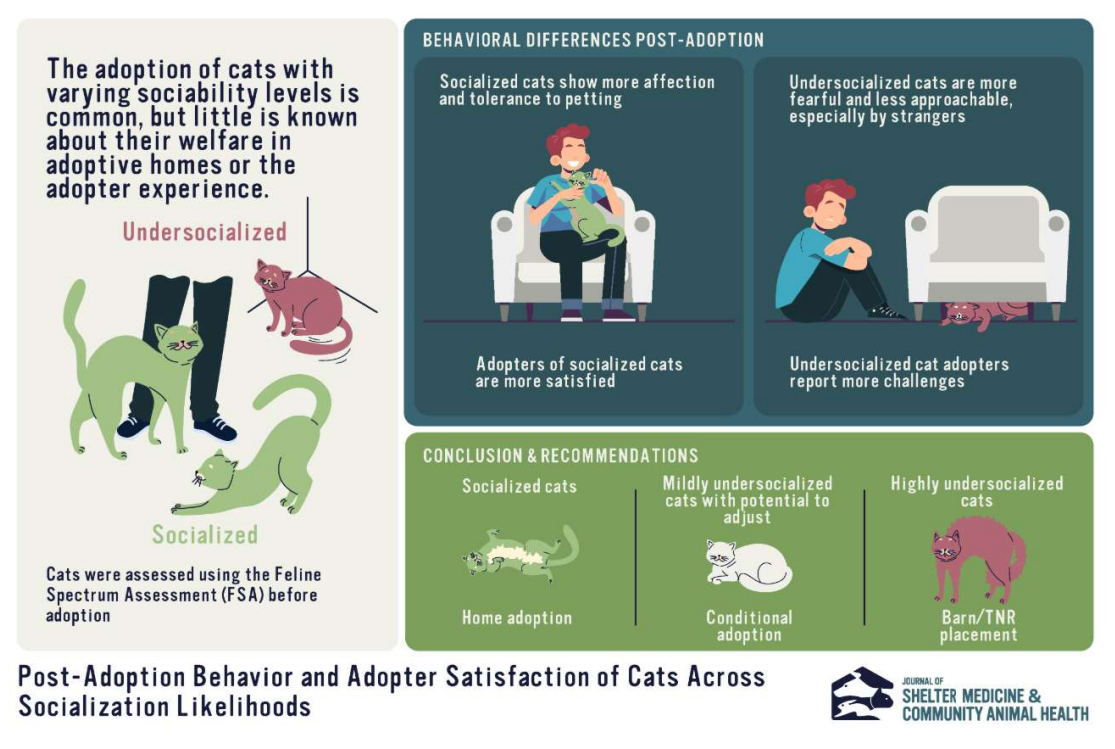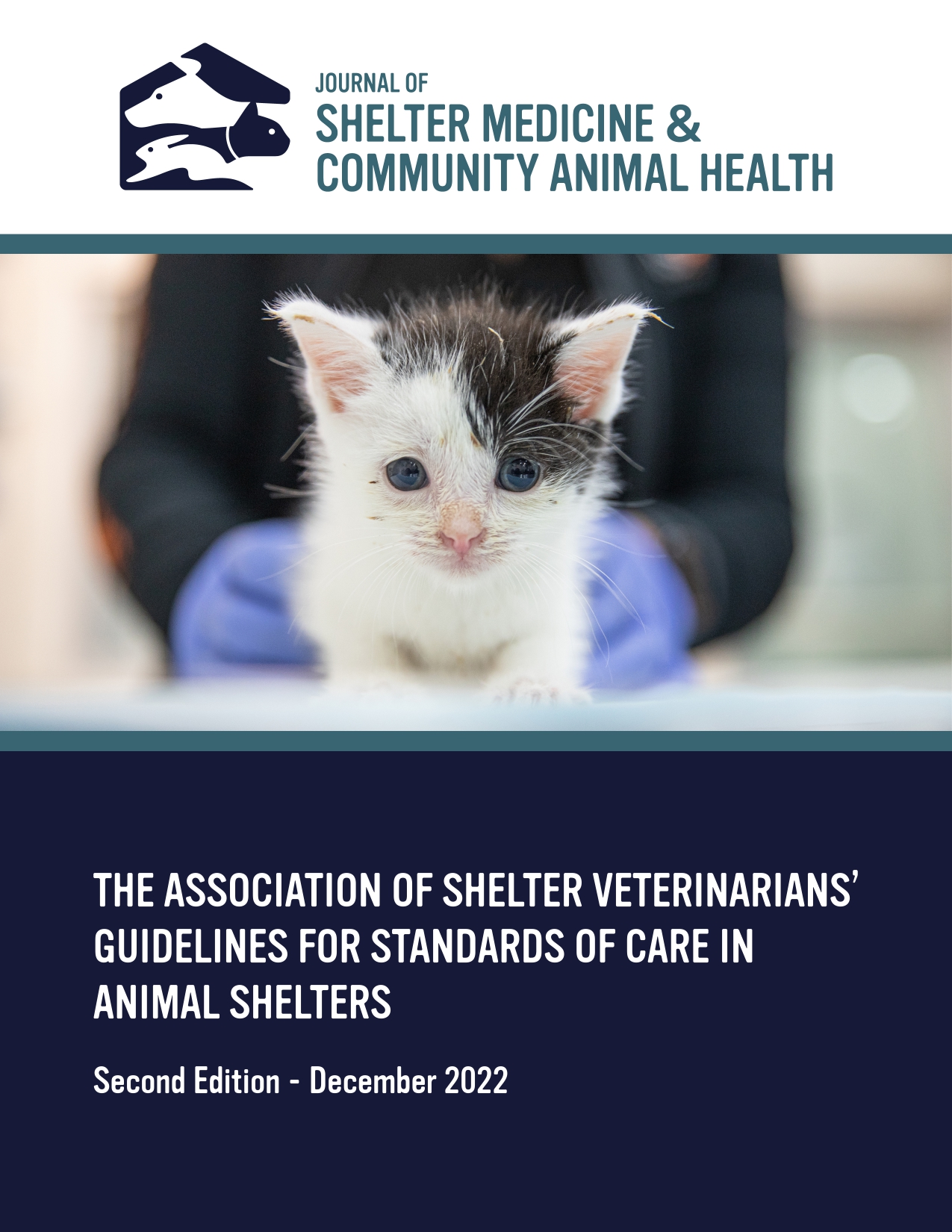Post-Adoption Behavior and Adopter Satisfaction of Cats Across Socialization Likelihoods
DOI:
https://doi.org/10.56771/jsmcah.v4.116Keywords:
Feline, adoptability, human-animal bond, welfare, feral, behaviour, Feline Spectrum Assessment, petting, approach, traits, animal shelterAbstract
Introduction: Cats with questionable sociability are routinely adopted into typical home environments, but there has been no published investigation into the welfare of these cats in their adoptive homes or the quality of the adopter experience. The objective of this study was to assess differences in post-adoption behavior and well-being between cats based on their likelihood of being socialized, as well as differences in adopter experience.
Methods: This prospective behavioral study surveyed adopters of cats assessed via the Feline Spectrum Assessment (FSA) and a randomly sampled control group (those never suspected of being undersocial) of cats with intake and adoption dates during the same period. Adopters reported on behavioral traits, situational behaviors, and adopter satisfaction.
Results: As the likelihood of being undersocial increased, cats were more fearful, less affectionate, and less amenable to approach and petting (more so by strangers, but also by their owners). Adopters of FSA cats reported being slightly less satisfied than control cat adopters. As the likelihood of being undersocial increased adopters were less likely to report a traditional home environment as the best environment for their pet than control cats.
Conclusion: This study provides evidence that cats never suspected of being undersocialized experience better welfare than undersocial cats, and their adopters are more satisfied. These results are more pronounced for cats found more likely to be undersocial by the FSA. Although it is becoming increasingly possible to find adoptive homes for poorly socialized cats, it does not appear to be in the best interest of many of these cats or adopters. The results of the FSA may be helpful for making pathway decisions for each cat; evidence suggests that at least FSA 1&2 cats should be slated for Trap Neuter Return (TNR) or barn placement unless significant progress is made in shelter.
Downloads
References
1.
Kraft W. Geriatrics in Canine and Feline Internal Medicine. Eur J Med Res. 1998;3(1–2):31–41.
2.
Jacobson LS, Ellis JJ, Janke KJ, Giacinti JA, Robertson JV. Behavior and Adoptability of Hoarded Cats Admitted to an Animal Shelter. J Feline Med Surg. 2022;24(8):e232–e243. doi: 10.1177/1098612X221102122
3.
Seo A, Ueda Y, Tanida H. Health Status of ‘Community Cats’ Living in the Tourist Area of the Old Town in Onomichi City, Japan. J Appl Anim Welf Sci. 2022;25(4):338–354. doi: 10.1080/10888705.2021.1874952
4.
Halls V, Bessant C. Managing Cat Populations Based on an Understanding of Cat Lifestyle and Population Dynamics. JSMCAH. 2023;2(S1):1–11. doi: 10.56771/jsmcah.v2.58
5.
Slater M, Garrison L, Miller K, Weiss E, Drain N, Makolinski K. Physical and Behavioral Measures that Predict Cats’ Socialization in an Animal Shelter Environment during a Three Day Period. Animals. 2013;3(4):1215–1228. doi: 10.3390/ani3041215
6.
Slater M, Garrison L, Miller K, Weiss E, Makolinski K, Drain N. Reliability and Validity of a Survey of Cat Caregivers on Their Cats’ Socialization Level in the Cat’s Normal Environment. Animals. 2013;3(4):1194–1214. doi: 10.3390/ani3041194
7.
Slater M, Garrison L, Miller K, et al. Practical Physical and Behavioral Measures to Assess the Socialization Spectrum of Cats in a Shelter-Like Setting during a Three Day Period. Animals. 2013;3(4):1162–1193. doi: 10.3390/ani3041162
8.
Slater MR, Miller KA, Weiss E, Makolinski KV, Weisbrot LAM. A Survey of the Methods Used in Shelter and Rescue Programs to Identify Feral and Frightened Pet Cats. J Feline Med Surg. 2010;12(8):592–600. doi: 10.1016/j.jfms.2010.02.001
9.
Slater MR. The Welfare of Feral Cats. In: Rochlitz I, ed. The Welfare Of Cats. Animal Welfare. Springer Netherlands; 2007:141–175. doi: 10.1007/978-1-4020-3227-1_6
10.
Eagan BH, Van Haaften K, Protopopova A. Daily Gabapentin Improved Behavior Modification Progress and Decreased Stress in Shelter Cats from Hoarding Environments in a Double-Blind Randomized Placebo-Controlled Clinical Trial. J Am Vet Med Assoc. 2023;261(9):1305–1315. doi: 10.2460/javma.23.01.0044
11.
Karsh EB, Turner DC. The Human-Cat Relationship. In: Knigh V, Bierach K, eds. The Domestic Cat: The Biology of Its Behaviour. Cambridge University Press; 1988:159–177.
12.
Gosling L, Stavisky J, Dean R. What is a Feral Cat?: Variation in Definitions May Be Associated With Different Management Strategies. Journal of Feline Medicine and Surgery. 2013;15(9):759–764. doi: 10.1177/1098612X13481034
13.
Halls V, Bessant C. Identifying Solutions for ‘Inbetweener’ Cats. JSMCAH. 2023;2(S1):1–13. doi: 10.56771/jsmcah.v2.59
14.
Ellis JJ. Beyond ‘doing better’: ordinal rating scales to monitor behavioural indicators of well-being in cats. Animals. 2022;12(21):2897. doi: 10.3390/ani12212897
15.
Converse J, Presser S. Survey Questions. SAGE Publications, Inc.; 1986. doi: 10.4135/9781412986045
16.
Ruel E, Wagner WE, Gillespie BJ. The Practice of Survey Research: Theory and Applications. SAGE Publications, Inc; 2016. doi: 10.4135/9781483391700
17.
Yammarino FJ, Skinner SJ, Childers TL. Understanding Mail Survey Response Behavior: A Meta-Analysis. Public Opin Q. 1991;55(4):613. doi: 10.1086/269284
18.
van Gelder MMHJ, Vlenterie R, IntHout J, Engelen LJLPG, Vrieling A, van de Belt TH. Most Response-Inducing Strategies Do Not Increase Participation in Observational Studies: A Systematic Review and Meta-Analysis. J Clin Epidemiol. 2018;99:1–13. doi: 10.1016/j.jclinepi.2018.02.019
19.
Brennan M, Benson S, Kearns Z. The Effect of Introductions on Telephone Survey Participation Rates. Int J Mark Res. 2005;47(1):65–74. doi: 10.1177/147078530504700104
20.
Bosnjak M, Tuten TL. Prepaid and Promised Incentives in Web Surveys: An Experiment. Social Science Computer Review. 2003;21(2):208–217. doi: 10.1177/0894439303021002006
21.
Gunn WJ, Rhodes IN. Physician Response Rates to a Telephone Survey: Effects of Monetary Incentive Level. Public Opin Q. 1981;45(1):109. doi: 10.1086/268638
22.
Tuten TL, Galesic M, Bosnjak M. Effects of Immediate Versus Delayed Notification of Prize Draw Results on Response Behavior in Web Surveys: An Experiment. Soc Sci Comput Rev. 2004;22(3):377–384. doi: 10.1177/0894439304265640
23.
Laguilles JS, Williams EA, Saunders DB. Can Lottery Incentives Boost Web Survey Response Rates? Findings from Four Experiments. Res High Educ. 2011;52(5):537–553. doi: 10.1007/s11162-010-9203-2
24.
Amat M, Camps T, Manteca X. Stress in Owned Cats: Behavioural Changes and Welfare Implications. J Feline Med Surg. 2016;18(8):577–586. doi: 10.1177/1098612X15590867
25.
Casey RA, Bradshaw JWS. The Assessment of Welfare. In: Rochlitz I, ed. The Welfare of Cats. Animal Welfare. Springer Netherlands; 2007:23–46. doi: 10.1007/978-1-4020-3227-1_2
26.
Vojtkovská V, Voslářová E, Večerek V. Methods of Assessment of the Welfare of Shelter Cats: A Review. Animals. 2020;10(9):1527. doi: 10.3390/ani10091527
27.
McCune S. The Impact of Paternity and Early Socialisation on the Development of Cats’ Behaviour to People and Novel Objects. Appl Anim Behav Sci. 1995;45(1–2):109–124. doi: 10.1016/0168-1591(95)00603-P
28.
Onodera N, Uchida K, Kakuma Y. Association between Characteristics of Cats and Satisfaction of Owners Who Adopted Cats from an Animal Hospital in Japan. J Vet Med Sci. 2014;76(5):729–733. doi: 10.1292/jvms.12-0569
29.
Scott S, Jong E, McArthur M, Hazel SJ. Follow-Up Surveys of People Who Have Adopted Dogs and Cats from an Australian Shelter. Appl Anim Behav Sci. 2018;201:40–45. doi: 10.1016/j.applanim.2017.12.021
30.
Zito S, Paterson M, Vankan D, Morton J, Bennett P, Phillips C. Determinants of Cat Choice and Outcomes for Adult Cats and Kittens Adopted from an Australian Animal Shelter. Animals. 2015;5(2):276–314. doi: 10.3390/ani5020276
31.
Neidhart L, Boyd R. Companion Animal Adoption Study. J Appl Anim Welf Sci. 2002;5(3):175–192. doi: 10.1207/S15327604JAWS0503_02
32.
Elvers GC, Lawriw AN. The Behavioral Style of the Cat Predicts Owner Satisfaction. Anthrozoös. 2019;32(6):757–768. doi: 10.1080/08927936.2019.1673038
33.
Normando S, Venturini T, Filugelli L, Bonetti O, Mutinelli F, Contalbrigo L. Cat-Human Bond: Satisfaction and Behavioural Complaints Among Italian Respondents. Appl Anim Behav Sci. 2022;256:105749. doi: 10.1016/j.applanim.2022.105749
34.
O’Connor R, Coe JB, Niel L, Jones-Bitton A. Exploratory Study of Adopters’ Concerns Prior to Acquiring Dogs or Cats from Animal Shelters. Soc Anim. 2017;25(4):362–383. doi: 10.1163/15685306-12341451
35.
Casey RA, Vandenbussche S, Bradshaw JWS, Roberts MA. Reasons for Relinquishment and Return of Domestic Cats (Felis Silvestris Catus) to Rescue Shelters in the UK. Anthrozoös. 2009;22(4):347–358. doi: 10.2752/089279309X12538695316185
36.
Mundschau V, Suchak M. When and Why Cats Are Returned to Shelters. Animals. 2023;13(2):243. doi: 10.3390/ani13020243
37.
Mertens C, Turner DC. Experimental Analysis of Human-Cat Interactions During First Encounters. Anthrozoös. 1988;2(2):83–97. doi: 10.2752/089279389787058109
38.
Travnik IC, Sant’Anna AC. Do You See The Same Cat That I See? Relationships between Qualitative Behaviour Assessment and Indicators Traditionally Used to Assess Temperament in Domestic Cats. Anim Welf. 2021;30(2):211–223. doi: 10.7120/09627286.30.2.211
39.
Buller K, Ballantyne KC. Living with and Loving a Pet with Behavioral Problems: Pet Owners’ Experiences. J Vet Behav. 2020;37:41–47. doi: 10.1016/j.jveb.2020.04.003

Additional Files
Published
Issue
Section
License
Copyright (c) 2025 The Authors

This work is licensed under a Creative Commons Attribution 4.0 International License.









